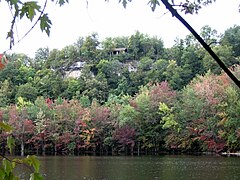Clark Reservation State Park
| Clark Reservation State Park | |
|---|---|

Glacier Lake and the cliff of the fossil waterfall in September
|
|
|
Location of Clark Reservation State Park in New York State
|
|
| Location | Onondaga County, New York, USA |
| Nearest city | Syracuse, New York |
| Coordinates | 42°59′42″N 76°05′35″W / 42.995°N 76.093°W |
| Created | 1928 |
| Visitors | 81,771 (in 2016) |
| Website | https://parks.ny.gov/parks/126/details.aspx |
Clark Reservation State Park is a state park in Onondaga County, New York. The park is in the Town of DeWitt, south of Syracuse. It was the site of a large waterfall at the end of the last Ice Age; the plunge basin at the base of the old falls is now a small lake. James Macfarlane described the area in 1879, "On approaching the lake from the turnpike on the south side, the tourist is startled at finding himself, without any notice, on the brink of a yawning gulf, precisely like that of the Niagara River below the Falls, and nearly as deep." Clark Reservation is also noted for its many ferns; it harbors the largest population in the U.S. of American hart's tongue, which is so rare that it was declared endangered in the U.S. in 1989.
The park is 377 acres (153 ha) in size, and logs about 80,000 visitors per year. It encompasses the cliff, plunge basin and gorge of the ancient waterfall, and a number of secondary ravines and basins. Glacier Lake, which occupies the plunge basin of the former waterfall, is 6.2 acres (2.5 ha) in size and 52 feet (16 m) deep; it is a rare meromictic lake in which the deep waters don't mix annually with the surface waters. The surrounding limestone cliffs are 180 feet (55 m) high. Hiking trails skirt a half-ring of cliffs surrounding the lake, as well as traversing the rugged limestone over which the old river flowed.
A Nature Center is operated by the Council of Park Friends, which is a nonprofit organization. The Center has exhibits about the park's geology and natural history, and is open from Memorial Day to Labor Day. In addition to staffing the Center, naturalists retained by the Council lead guided hikes in the park. In addition, the park offers fishing, a nature trail, picnic tables and pavilions, a playground, and recreation programs.
Before the arrival of the Europeans, the land around the park belonged probably to Onondaga people. In the late 18th century, these areas were divided into Military tracts for soldiers of the Revolutionary War. Joshua Clark noted the lake and its precipitous cliffs in his 1840 book about Onondaga County. In 1879, James Macfarlane purchased the area around the fossil waterfall and the lake, and opened a small resort hotel in the park. Macfarlane (1819–1885) was a noted attorney, coal geologist, geological guidebook writer, and enthusiast of the area near Green (latterly Glacier) Lake. The resort's offerings included picnicking, boating, fishing, croquet and archery, but it closed after a few years.
...
Wikipedia

